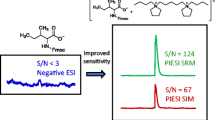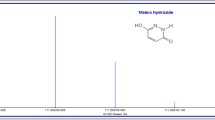Abstract
A reversed-phase ion-pairing chromatographic method was developed for the detection and quantification of inorganic and organic anionic food additives. A single-stage high-resolution mass spectrometer (orbitrap ion trap, Orbitrap) was used to detect the accurate masses of the unfragmented analyte ions. The developed ion-pairing chromatography method was based on a dibutylamine/hexafluoro-2-propanol buffer. Dibutylamine can be charged to serve as a chromatographic ion-pairing agent. This ensures sufficient retention of inorganic and organic anions. Yet, unlike quaternary amines, it can be de-charged in the electrospray to prevent the formation of neutral analyte ion-pairing agent adducts. This process is significantly facilitated by the added hexafluoro-2-propanol. This approach permits the sensitive detection and quantification of additives like nitrate and mono-, di-, and triphosphate as well as citric acid, a number of artificial sweeteners like cyclamate and aspartame, flavor enhancers like glutamate, and preservatives like sorbic acid. This is a major advantage, since the currently used analytical methods as utilized in food safety laboratories are only capable in monitoring a few compounds or a particular category of food additives.

Deptotonation of ion pair agent in the electrospray interface


Similar content being viewed by others
References
Kubica P, Namiesnik J, Wasik A. Sweeteners and common Stevia rebaudiana glycosides in non-alcoholic and alcoholic beverages by reversed-phase liquid chromatography coupled with tandem mass spectrometry. J Anal Bioanal Chem. 2014;406:1505–12. https://doi.org/10.1007/s00216-014-8355-x.
Lorenzo-Fernandez M, Lopez-Hernandez J, Pineiro-Sotelo M, Rodriguez-Bernaldo A. High performance liquid chromatography for joint determination of the flavour enhancers monosodium glutamate, disodium guanylate and disodium inosinate in dehydrated bouillons. Dtsch Lebensm Rundsch. 2002;98:93–895.
Chang CS, Yeh TS. Detection of 10 sweeteners in various foods by liquid chromatography/tandem mass spectrometry. J Food Drug Anal. 2014;22:318–28. https://doi.org/10.1016/j.jfda.2014.01.024.
Goncalves AG, Rech TB, Rodrigues PM. Quality evaluation of frozen seafood (Genypterus brasiliensis, Prionotus punctatus, Pleoticus muelleri and Perna perna) previously treated with phosphates. Pan-Am J Aquat Sci. 2008;3(3):248–58.
Ruiz-Calero V, Galceran MT. Ion chromatography separations of phosphorus species: a review. Talanta. 2005;66:376–410. https://doi.org/10.1016/j.talanta.2005.01.027.
Kaufmann A, Maden K, Leisser W, Gude T. Analysis of polyphosphates in fish and shrimps tissues by two different ion chromatographyy methods: implications on false-negative and positive findings. Food Addit Contam. 2005;22:1073–82. https://doi.org/10.1080/02652030500239565.
Baluyot E, Hartford C. Comparison of polyphosphate analysis by ion chromatography and by modified end-group titration. J Chrom A. 1996;739:217–22.
Iammarino M, Di Taranto A. Determination of polyphosphates in products of animal origin: application of a validated ion chromatography method for commercial analyses. Eur Food Res Technol. 2012;235:409–17.
Dafflon O, Scheurer O, Gobet H, Bossed J. Polyphosphate determination in seafood and processed cheese using high-performance anion-exchange chromatography after phosphatase inhibition using microwave heat shock. Mitt Lebensm Hyg. 2003;94:127–35.
Gallidabinio MD, Hamdan L, Murphy B, Barron L. Suspect screening of halogenated carboxylic acids in drinking water using ion exchange chromatography–high resolution (Orbitrap) mass spectrometry (IC-HRMS). Talanta. 2018;178:57–68.
Gilchrist E, Nesterenko P, Smith N, Barron L. Organic solvent and temperature-enhanced ion chromatography-high resolution mass spectrometry for the determination of low molecular weight organic and inorganic anions. Anal Chim Acta. 2015;865:83–91. https://doi.org/10.1016/j.aca.2015.01.031.
Saccani C, Tanzi E, Cavalli S, Rohrer J. Determination of nitrite, nitrate, and glucose-6-phosphate in muscle tissues and cured meat by LC/MS. J AOAC. 2006;89:712–9.
Studzinska S, Rola R, Buszewski B. The impact of ion-pairing reagents on the selectivity and sensitivity in the analysis of modified oligonucleotides in serum samples by liquid chromatography coupled with tandem mass spectrometry. J Pharm Biomed Anal. 2017;138:146–52. https://doi.org/10.1016/j.pba.2017.02.014.
Basiri B, van Hattum H, van Dongen WD, Murph MM, Barlett MG. The rule of fluorinated alcohols as mobile phase modifiers for LC-MS analysis of oligonucleotides. J Am Soc Mass Spectr. 2017;28:190–9. https://doi.org/10.1007/S13361-016-1500-3.
Birdsall RE, Gilar M, Shion H, Yu YQ, Chen W. Reduction of metal adducts in oligonucleotide mass spectra in ion-pair reversed-phase chromatography/mass spectrometry analysis. Rapid Commun Mass Spectr. 2016;30:1667–79. https://doi.org/10.1002/rcm.7596.
Konieczka P, Namiesnik J. Estimation uncertainty in analytical procedures based on chromatographic techniques. J Chrom A. 2010;1217:882–91.
Author information
Authors and Affiliations
Corresponding author
Ethics declarations
The authors adhered to ethical standards.
Conflict of interest
The authors declare that they have no conflicts of interest.
Ethical approval
No studies involving human participants or animals were conducted.
Informed consent
Not applicable.
Additional information
Published in the topical collection Food Safety Analysis with guest editor Steven J. Lehotay.
Rights and permissions
About this article
Cite this article
Kaufmann, A., Widmer, M., Maden, K. et al. Analysis of a variety of inorganic and organic additives in food products by ion-pairing liquid chromatography coupled to high-resolution mass spectrometry. Anal Bioanal Chem 410, 5629–5640 (2018). https://doi.org/10.1007/s00216-018-0904-2
Received:
Revised:
Accepted:
Published:
Issue Date:
DOI: https://doi.org/10.1007/s00216-018-0904-2




